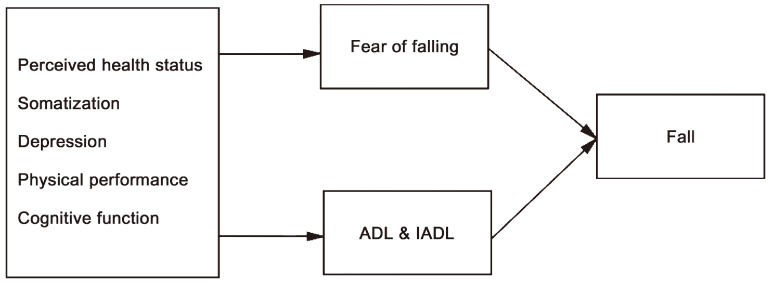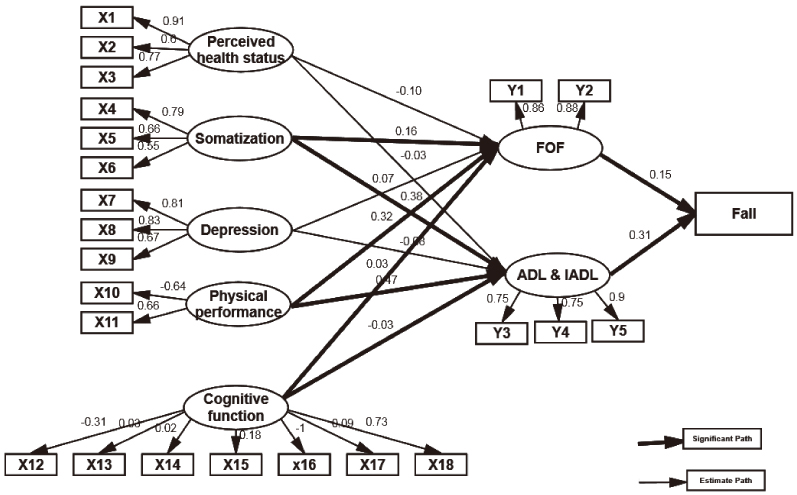J Korean Acad Nurs.
2012 Dec;42(6):810-818. 10.4040/jkan.2012.42.6.810.
Fall Prediction Model for Community-dwelling Elders based on Gender
- Affiliations
-
- 1Ewha Womans University, Seoul, Korea. yes100406@naver.com
- KMID: 1499508
- DOI: http://doi.org/10.4040/jkan.2012.42.6.810
Abstract
- PURPOSE
This study was done to explore factors relating to number of falls among community-dwelling elders, based on gender.
METHODS
Participants were 403 older community dwellers (male=206, female=197) aged 60 or above. In this study, 8 variables were identified as predictive factors that can result in an elderly person falling and as such, supports previous studies. The 8 variables were categorized as, exogenous variables; perceived health status, somatization, depression, physical performance, and cognitive state, and endogenous variables; fear of falling, ADL & IADL and frequency of falls.
RESULTS
For men, ability to perform ADL & IADL (beta32=1.84, p<.001) accounted for 16% of the variance in the number of falls. For women, fear of falling (beta31=0.14, p<.05) and ability to perform ADL & IADL (beta32=1.01, p<.001) significantly contributed to the number of falls, accounting for 15% of the variance in the number of falls.
CONCLUSION
The findings from this study confirm the gender-based fall prediction model as comprehensive in relation to community-dwelling elders. The fall prediction model can effectively contribute to future studies in developing fall prediction and intervention programs.
MeSH Terms
Figure
Cited by 1 articles
-
Predictors of Accidental Falls in the Community-dwelling Elderly by Age
Nan Ju Park, Yong Soon Shin
J Korean Acad Community Health Nurs. 2019;30(2):141-149. doi: 10.12799/jkachn.2019.30.2.141.
Reference
-
1. Andresen EM, Wolinsky FD, Miller JP, Wilson MM, Malmstrom TK, Miller DK. Cross-sectional and longitudinal risk factors for falls, fear of falling, and falls efficacy in a cohort of middle-aged African Americans. Gerontologist. 2006. 46:249–257. http://dx.doi.org/10.1093/geront/46.2.249.2. Bae B. Structural equation modeling with Amos 17.0 -Principles and practice-. 2009. Seoul: Chung Ram Books.3. Choi K, Park U, Lee I. Factors influencing the fear of falling according to gender in frail elderly. J Korean Gerontol Soc. 2011. 31:539–551.4. Ding L, Velicer WF, Harlow LL. Effects of estimation methods, number of indicators per factor, and improper solutions on structural equation modeling fit indices. Struct Equ Modeling. 1995. 2:119–143. http://dx.doi.org/10.1080/10705519509540000.5. Folstein MF, Folstein SE, McHugh PR. "Mini-Mental-State": A practical method for grading the cognitive state of patients for the clinician. J Psychiatr Res. 1975. 12:189–198. http://dx.doi.org/10.1016/0022-3956(75)90026-6.6. Gassmann KG, Rupprecht R, Freiberger E. Predictors for occasional and recurrent falls in community-dwelling older people. Z Gerontol Geriatr. 2009. 42:3–10. http://dx.doi.org/10.1007/s00391-008-0506-2.7. Hwang MH. A model of self-care and well being of elderly. 2000. Daegu: Kyungpook National University;Unpublished doctoral dissertation.8. Kang Y, Na DL, Hahn S. A validity study on the Korean Mini-Mental State Examination (K-MMSE) in dementia patients. J Korean Neurol Assoc. 1997. 15:300–308.9. Katz S, Ford AB, Moskowitz RW, Jackson BA, Jaffe MW. Studies of illness in the aged. The index of ADL: A standardized measure of biological and psychosocial function. JAMA. 1963. 185:914–919. http://dx.doi.org/10.1001/jama.1963.03060120024016.10. Kee BS. A preliminary study for the standardization of geriatric depression scale short form - Korea version. J Korean Neuropsychiatr Assoc. 1996. 35:298–307.11. Kempen GI, van Haastregt JC, McKee KJ, Delbaere K, Zijlstra GA. Socio-demographic, health-related and psychosocial correlates of fear of falling and avoidance of activity in community-living older persons who avoid activity due to fear of falling. BMC Public Health. 2009. 9:170. http://dx.doi.org/10.1186/1471-2458-9-170.12. Kim JM. An analysis of falls in the elderly: A PRECEDE model approach. 2008. Seoul: Ewha Womans University;Unpublished doctoral dissertation.13. Kim S, Chun Y. The effect of level of physical strength, depression, and daily lives on falling of the elders using senior center. J Sport Leis Stud. 2010. 39:755–762.14. Kim TG. A study of fear of falling and IADL in an urban and a rural population. 2010. Seoul: Hanyang University;Unpublished doctoral dissertation.15. Korea National Statistical Office. Statistical report on the aged 2011. 2011. Retrieved September 29, 2011. from http://kostat.go.kr/portal/korea/kor_nw/2/1/index.board?bmode=read&aSeq=250718.16. Kroenke K, Spitzer RL, Williams JB. The PHQ-15: Validity of a new measure for evaluating the severity of somatic symptoms. Psychosom Med. 2002. 64:258–266.17. Lawton MP, Brody EM. Assessment of older people: Self maintaining and instrumental activities of daily living. Gerontologist. 1969. 9:179–186. http://dx.doi.org/10.1093/geront/9.3_Part_1.179.18. Lee KJ, Park HS. A study on the perceived health status, depression, and activities of daily living for the elderly in urban areas. Korean J Women Health Nurs. 2006. 12:221–230.19. Lee YH, Lee KJ, Han GS, Yoon SJ, Lee YK, Kim CH, et al. The development of physical functioning scale for community-dwelling older persons. Korean J Prev Med. 2002. 35:359–374.20. Mathias S, Nayak US, Issacs B. Balance in elderly patients: The "Get-up and Go" test. Arch Phys Med Rehabil. 1986. 67:387–389.21. Park JW, Yoo H. Fear of falling, ADL and physical functioning among senior citizens. Korean J Rehabil Nurs. 2006. 9:117–125.22. Rubenstein LZ, Josephson KR. Falls and their prevention in elderly people: What does the evidence show? Med Clin North Am. 2006. 90:807–824. http://dx.doi.org/10.1016/j.mcna.2006.05.013.23. Scheffer AC, Schuurmans MJ, van Dijk N, van der Hooft T, de Rooij SE. Fear of falling: Measurement strategy, prevalence, risk factors, and consequences among older persons. Age Ageing. 2008. 37:19–24. http://dx.doi.org/10.1093/ageing/afm169.24. Sheikh JI, Yesavage JA. Geriatric depression scale (GDS): Recent evidence and development of a shorter version. Clin Gerontol. 1986. 5:165–173. http://dx.doi.org/10.1300/J018v05n01_09.25. Speake DL, Cowart ME, Pellet K. Health perceptions and lifestyles of the elderly. Res Nurs Health. 1989. 12:93–100. http://dx.doi.org/10.1002/nur.4770120206.26. Spitzer RL, Kroenke K, Williams JB. Validation and utility of a self-report version of PRIME-MD. JAMA. 1999. 282:1737–1744. http://dx.doi.org/10.1001/jama.282.18.1737.27. Steiger JH. Structural model evaluation and modification: An interval estimation approach. Multivariate Behav Res. 1990. 25:173–180. http://dx.doi.org/10.1207/s15327906mbr2502_4.28. Yoo IY. Effects of fall prevention program applying HSEP on physical balance and gait, leg strength, fear of falling and falls efficacy of community-dwelling elderly. J Korean Gerontol Soc. 2009. 29:259–273.29. Yoo IY. Analysis of multi-variate recurrent fall risk factors in elderly people using residential assessment instrument-home carecomparisons between single and recurrent fallers. J Korean Acad Nurs. 2011. 41:119–128. http://dx.doi.org/10.4040/jkan.2011.41.1.119.30. Zijlstra GA, van Haastregt JC, van Eijk JTh, van Rossum E, Stalenhoef PA, Kempen GI. Prevalence and correlates of fear of falling, and associated avoidance of activity in the general population of community-living older people. Age Ageing. 2007. 36:304–309. http://dx.doi.org/10.1093/ageing/afm021.
- Full Text Links
- Actions
-
Cited
- CITED
-
- Close
- Share
- Similar articles
-
- A Structural Equation Model of Fall Prevention Behavior among Community-dwelling Older Adults with Osteoarthritis
- Factors Associated with Fear of Falling by Fall Experience in the Community-dwelling Elderly
- Factors Influencing Ego-Integrity in Community Dwelling Elders
- Factors influencing fall in the community-dwelling elderly: Data from the 2020 national survey of older people: A secondary analysis study
- Relations among Knowledge, Fear and Efficacy of Fall in the Community Dwelling Elderly




